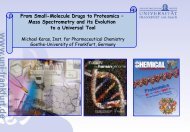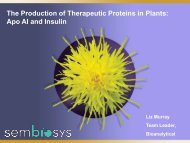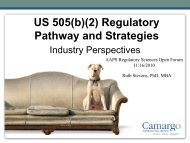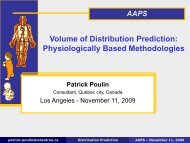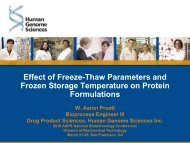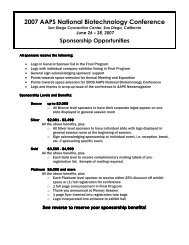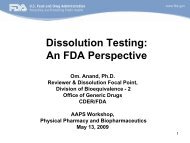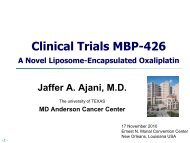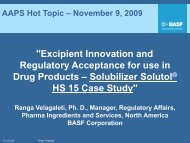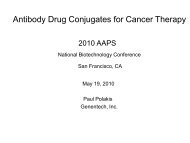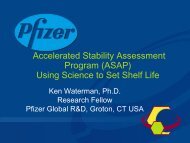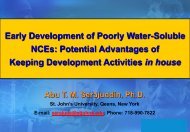Preliminary Program - American Association of Pharmaceutical ...
Preliminary Program - American Association of Pharmaceutical ...
Preliminary Program - American Association of Pharmaceutical ...
Create successful ePaper yourself
Turn your PDF publications into a flip-book with our unique Google optimized e-Paper software.
54<br />
2009 AAPS Annual Meeting and Exposition<br />
AAPS Formulation, Design and Development (FDD) <strong>Program</strong>ming<br />
Moderator<br />
Umang Shah, Ph.D.<br />
Solvay<br />
FDA’s Perspective<br />
Moheb Nasr, Ph.D., invited<br />
U.S. Food and Drug Administration<br />
USP Perspective on Performance Related<br />
Tests for Excipients<br />
Kevin Moore, Ph.D.<br />
United States Pharmacopeia (USP)<br />
Excipient User’s Perspective<br />
Mohan Ganapathy, Ph.D.<br />
Merck and Co., Inc.<br />
Excipient Manufacturer’s Perspective<br />
Richard C. Moreton, Ph.D.<br />
Finnbrit Consulting<br />
WEDNESDAY MORNING MINI-SYMPOSIA<br />
9:00 am – 11:00 am<br />
Intestinal Delivery <strong>of</strong> Lipidic Drug<br />
Complexes and Conjugates:<br />
Case Studies<br />
Mini-symposium<br />
Lipid-drug complexes arise from non-covalent<br />
association <strong>of</strong> a drug with a lipidic carrier usually<br />
mediated by electrostatic and/or hydrogen bonding<br />
interactions. In contrast, lipid-drug conjugates<br />
comprise covalent conjugates <strong>of</strong> drug and a lipidic<br />
moiety, such as a fatty acid, a glyceride, other<br />
neutral lipid, or a phospholipid. The development<br />
<strong>of</strong> lipidic drug complexes and conjugates for<br />
pharmaceutical applications is driven primarily<br />
by the need to target drugs to specific sites in the<br />
body and/or to improve their biopharmaceutical or<br />
physicochemical properties. Lipidic drug conjugates<br />
are generally designed to exhibit characteristics<br />
which mimic those <strong>of</strong> dietary lipids, a key<br />
consideration in their utilization for oral delivery.<br />
These conjugates may provide enhanced intestinal<br />
permeability, improved GI stability, tolerability,<br />
and increased potential for intestinal lymphatic<br />
transport. In the latter case, for drugs with high<br />
first pass metabolism, recruitment <strong>of</strong> lymphatic<br />
transport via a prodrug strategy can provide for<br />
very significant increases in oral bioavailability.<br />
Alternatively, drug lipid/phospholipid conjugates<br />
can significantly alleviate the GI-injury induced<br />
by NSAIDs, such as aspirin and indomethacin. In<br />
contrast, the generation <strong>of</strong> drug:lipid complexes<br />
via drug complexation with excipients in lipidbased<br />
drug delivery systems, such as SEDDS, can<br />
reduce drug solubility, absorption, and is an <strong>of</strong>ten<br />
overlooked but critical aspect <strong>of</strong> formulation design.<br />
The objective <strong>of</strong> this symposium is to discuss recent<br />
advances in understanding and present case studies<br />
in the use <strong>of</strong> drug-lipid conjugates and drug-lipid<br />
complexes. Product development challenges<br />
and considerations particularly in reference to<br />
the impact <strong>of</strong> complexation and conjugation on<br />
pharmacokinetic and pharmacodynamic endpoints<br />
and the implications in terms <strong>of</strong> regulatory approval<br />
will be highlighted throughout the symposium.<br />
Moderator<br />
Panayiotis P. Constantinides, Ph.D.<br />
Biopharmaceutical and Drug Delivery Consulting, LLC<br />
Targeting Lipidic Prodrugs to the Lymphatics<br />
Christopher J. H. Porter, Ph.D.<br />
Monash Institute <strong>of</strong> <strong>Pharmaceutical</strong> Sciences,<br />
Monash University<br />
Drug-excipient Complexation in Selfemulsifying<br />
Drug Delivery Systems and<br />
Implications for Excipient Selection in<br />
Lipid-based Drug Delivery Systems<br />
Shirlynn Chen, Ph.D.<br />
Boehringer Ingelheim <strong>Pharmaceutical</strong>s, Inc.<br />
Improving Gastrointestinal Safety <strong>of</strong><br />
Non-steroidal Anti-inflammatory Drugs<br />
with Phospholipids<br />
Upendra Marathi, Ph.D.<br />
PLx Pharma<br />
Thursday, November 12, 2009<br />
THURSDAY SUNRISE SESSIONS<br />
7:00 am – 8:15 am<br />
Modeling Ophthalmic Drug Delivery<br />
and Disposition<br />
Sunrise Session<br />
Sophisticated models for ocular drug disposition<br />
are becoming available, but there is little literature<br />
information on how accurate the models are, and<br />
to what problems they have been applied. This<br />
session will <strong>of</strong>fer case studies in how these models<br />
have been applied, what insights have been gained,<br />
and what limitations have been experienced. Since<br />
sophisticated modeling and simulation <strong>of</strong> drug<br />
delivery is a relatively young field, this session is <strong>of</strong><br />
broader interest not only for those scientists trying<br />
to build PK models, but also for the pharmacokinetic<br />
and drug delivery scientists trying to utilize those<br />
models to speed up drug development.<br />
Moderator<br />
Brian Rohrs, Ph.D.<br />
Bausch & Lomb<br />
Modeling for Ophthalmic Drug Development<br />
John Crison, Ph.D.<br />
Simulations Plus, Inc.<br />
THURSDAY SYMPOSIA<br />
8:30 am – 11:00 am<br />
Hot-melt Extrusion: A Novel Oral Solids<br />
Processing Technology<br />
Symposium<br />
The advent <strong>of</strong> high throughput screening in the drug<br />
discovery has resulted in compounds with high<br />
lipophilicity and poor solubility. Various approaches<br />
have been adopted to address these solubility<br />
issues including preparation <strong>of</strong> solid dispersions/<br />
solid solutions. Any new chemical entities, as well as<br />
existing drugs that demonstrate poor bioavailability<br />
due to solubility issues are prime candidates for<br />
hot-melt extrusion (HME). The numerous advantages<br />
<strong>of</strong> HME technology include shorter and more<br />
efficient times to the final product, environmental<br />
advantages due to elimination <strong>of</strong> solvents in<br />
processing, and increased efficiency <strong>of</strong> drug delivery<br />
to the patient. HME has been demonstrated to<br />
provide rapid, sustained, modified, and targeted<br />
drug delivery. A variety <strong>of</strong> hot-melt polymers (both<br />
hydrophilic as well as hydrophobic) and lipid-based<br />
matrices have been used in different applications<br />
to obtain tailored release pr<strong>of</strong>iles for selected active<br />
pharmaceutical ingredients (APIs). Improvements in<br />
bioavailability utilizing HME techniques demonstrate<br />
the value <strong>of</strong> the technology as a potential drug<br />
delivery-processing tool. Amorphous forms <strong>of</strong><br />
drugs with high amounts <strong>of</strong> energy produced from<br />
the HME process aid in enhancement <strong>of</strong> solubility<br />
<strong>of</strong> such drugs. The interest in HME technology for<br />
pharmaceutical applications is evident from the<br />
increasing number <strong>of</strong> patents and publications in<br />
the scientific literature. Although some aspects <strong>of</strong><br />
HME dosage forms were presented in earlier AAPS<br />
meetings, there was no comprehensive discussion<br />
<strong>of</strong> various applications and advancements in<br />
this technology. The proposed objective <strong>of</strong> this<br />
symposium is to present the latest developments<br />
and myriad <strong>of</strong> applications <strong>of</strong> HME technology for<br />
pharmaceutical dosage forms including granules,<br />
pellets, tablets, implants, and transmucosal<br />
systems. For example, low temperature HME<br />
techniques will be discussed. Topics will cover case<br />
studies including HME applied to the formulation<br />
design <strong>of</strong> highly water insoluble and thermodegradable<br />
drugs. It will also deal with the specific<br />
problems associated with these techniques and its<br />
plausible solutions (technology and formulation<br />
design related) so that the span <strong>of</strong> this technology<br />
widens. The challenges related to HME dosage forms<br />
will be discussed from the regulatory perspective<br />
for the improvement <strong>of</strong> our understanding <strong>of</strong> the<br />
regulatory issues faced by these techniques and the<br />
products produced by this innovative technology.<br />
This symposium is targeted to reveal the novel<br />
applications <strong>of</strong> HME technology for constantly<br />
evolving oral solid dosage form technology, which is<br />
continuing to shift the paradigm <strong>of</strong> pharmaceutical<br />
processing and drug delivery systems.



